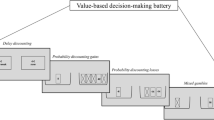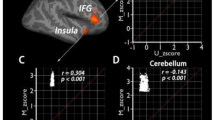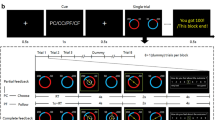Abstract
Loss-aversion behaviors reflect individuals’ personal preference bias when they meet uncertainties and measure the potential gains and losses of the uncertain situations before making a decision. Such behaviors are common and well documented in daily life; one example is irrational financial investments. The exact neural mechanisms for these loss-aversion behaviors have been widely discussed. In this study, we explored the neural mechanisms of loss-aversion behaviors by using voxel-based morphometry of brain regions based on two datasets. In the behavioral analysis, the degree of individual behavioral loss aversion was measured. Voxel-based morphometry analysis revealed positive correlations between the degree of individual behavioral loss aversion and grey matter volume in the superior frontal gyrus, which may be crucial neural structures for individual loss-aversion behaviors.




Similar content being viewed by others
References
Abdellaoui, M., Bleichrodt, H. & Paraschiv, C. (2006). Loss aversion under prospect theory: A parameter-free measurement. Available at SSRN: http://ssrn.com/abstract=956613.
Adolphs, R., Tranel, D., Damasio, H., & Damasio, A. R. (1995). Fear and the human amygdala. The Journal of Neuroscience, 15, 5879–5891.
Ariely, D., Huber, J., & Wertenbroch, K. (2005). When do losses loom larger than gains? Journal of Marketing Research, 42, 134–138.
Ashburner, J. (2007). A fast diffeomorphic image registration algorithm. Neuroimage, 38, 95–113.
Augustine, J. R. (1996). Circuitry and functional aspects of the insular lobe in primates including humans. Brain Structure & Function, 214, 655–667.
Awh, E., & Gehring, W. J. (1999). The anterior cingulate cortex lends a hand in response selection. Nature Neuroscience, 2, 853–854.
Bates, J. F., & Goldman-Rakic, P. S. (1993). Prefrontal connections of medial motor areas in the rheses monkey. The Journal of Comparative Neurology, 336, 211–228.
Bechara, A. (2004). Disturbances of emotion regulation after focal brain lesions. International Review of Neurobiology, 62, 159–193.
Benjamin, D.J., Berger, J., Johannesson, M., Nosek, B.A., Wagenmakers, E., Berk, R., … Johnson, V. (2018). Redefine statistical significance. Nature Human Behaviour, 2, 6–10.
Benjamini, Y., & Hochberg, Y. (1995). Controlling the false discovery rate: A practical and powerful approach to multiple testing. Journal of the Royal Statistical Society, Series B, 57(1), 289–300.
Bjork, J. M., Knutson, B., Fong, G. W., Caggiano, D. M., Bennett, S. M., & Hommer, D. W. (2004). Incentive-elicited brain activation in adolescents: Similarities and differences from young adults. The Journal of Neuroscience, 24, 1793–1802.
Botvinick, M. M. (2007). Conflict monitoring and decision making: Reconciling two perspectives on anterior cingulate function. Cognitive, Affective, & Behavioral Neuroscience, 7, 356–366.
Breiter, H. C., Aharon, I., Kahneman, D., Dale, A., & Shizgal, P. (2001). Functional imaging of neural responses to expectancy and experience of monetary gains and losses. Neuron, 30, 619–639.
Buades, A., Coll, B., & Morel, J. M. (2005). A non-local algorithm for imaging denoising. IEEE Computer Vision and Pattern Recognition, 2005(2), 60–65.
Buchel, C., & Dolan, R. J. (2000). Classical fear conditioning in functional neuroimaging. Current Opinion in Neurobiology, 10, 219–223.
Bush, G., Luu, P., & Posner, M. I. (2000). Cognitive and emotional influences in anterior cingulate cortex. Trends in Cognitive Sciences, 4, 215–222.
Canessa, N., Crespi, C., Motterlini, M., Baud-Bovy, G., Chierchia, G., Pantaleo, G., & Cappa, S. (2013). The functional and structural neural basis of individual differences in loss aversion. The Journal of Neuroscience, 33, 14307–14317.
Chua, P., Krams, M., Toni, I., Passingham, R., & Dolan, R. (1999). A functional anatomy of anticipatory anxiety. Neuroimage, 9, 563–571.
Craig, A. D. (2002). How do you feel? Interoception: The sense of the physiological condition of the body. Nature Reviews. Neuroscience, 3, 655–666.
Critchley, H. D. (2004). The human cortex reponds to an interoceptive challenge. Proceedings of the National Academy of Sciences of the United States of America, 101, 6333–6334.
Crottaz-Herbette, S., & Menon, V. (2006). Where and when the anterior cingulate cortex modulates attentional response: Combined fRMI and ERP evidence. Journal of Cognitive Neuroscience, 18, 766–780.
Damasio, A. R., Everitt, B. J., & Bishop, D. (1996). The somatic marker hypothesis and the possible functions of the prefrontal cortex. Philosophical Transactions of the Royal Society of London. Series B, Biological Sciences, 351, 1413–1420.
De Martino, B., Camerer, C. F., & Adolphs, R. (2010). Amygdala damage eliminates monetary loss aversion. Proceedings of the National Academy of Sciences of the United States of America, 107, 3788–3792.
Duncan, J. (2001). An adaptive coding model of neural function in prefrontal cortex. Nature Reviews. Neuroscience, 2(11), 820–829.
Farrer, C., Frank, N., Georgieff, N., Frith, C. D., Decety, J., & Jeannerod, M. (2003). Modulating the experience of agency: A positron emission tomography study. Neuroimage, 18, 324–333.
Faul, F., Erdfelder, E., Buchner, A., & Lang, A. G. (2009). Statistical power analyses using G*power 3.1: Tests for correlation and regression analyses. Behavior Research Methods, 41, 1149–1160.
Gehring, W. J., & Fencsik, D. E. (2001). Functions of the medial frontal cortex in the processing of conflict and errors. The Journal of Neuroscience, 21, 9430–9437.
Gray, M. A., Harrison, N. A., Wiens, S., & Critchley, H. D. (2007). Modulation of emotional appraisal by false physiological feedback during fMRI. PLoS One, 2, e456.
Haigh, M., & List, J. (2005). Do professional traders exhibit myopic loss aversion? An experimental analysis. The Journal of Finance, 60, 523–534.
Hsu, M., Bhatt, M., Adolphs, R., Tranel, D., & Camerer, C. F. (2005). Neural systems responding to degrees of uncertainty in human decision-making. Science, 310, 1680–1683.
Kahn, I., Yeshurun, Y., Rotshtein, P., Fried, I., Ben-Bashat, D., & Hendler, T. (2002). The role of the amygdala in signaling prospective outcome of choice. Neuron, 33, 983–994.
Kahneman, D., & Tversky, A. (1979). Prospect theory: An analysis of decision under risk. Econometrica, 47, 263292.
Knutson, B., Adams, C. M., Fong, G. W., & Hommer, D. W. (2001). Anticipation of increasing monetary reward selectively recruits nucleus accumbens. The Journal of Neuroscience, 21, RC159.
Knutson, B., Taylor, J., Kaufman, M. T., Peterson, R., & Glover, G. (2005). Distributed neural representation of expected value. The Journal of Neuroscience, 25, 4806–4812.
Li, W., Qin, W., Liu, H., Fan, L., Wang, J., Jiang, T., & Yu, C. (2013). Subregions of the human superior frontal gyrus and their connections. Neuroimage, 78, 46–58.
Liston, D. B., & Stone, L. S. (2008). Effects of prior information and reward on oculomotor and perceptual choices. The Journal of Neuroscience, 28(51), 13866–13875.
Luo, Q., Mitchell, D., Jones, M., Mondillo, K., Vythilingam, M., & Blair, R. J. (2007). Common regions of dorsal anterior cingulate and prefrontal-parietal cortices provide attentional control of distracters varying in emotionally and visibility. NeuroImage, 38, 631–639.
Markett, S., Heeren, G., Montag, C., Weber, B., & Reuter, M. (2016). Loss aversion is associated with bilateral insular volume. A voxel based morphometry study. Neuroscience Letters, 619, 172–176.
Martinez, D., Slifstein, M., Broft, A., Malawi, O., Hwang, D. R., Huang, Y., Cooper, T., Kegeles, L., Zarahn, E., & Abi-Dargham, A. (2003). Imaging human mesolimbic dopamine transmission with positron emission tomography. Part II: Amphetamine-induced dopamine release in the functional subdivisions of the striatum. Journal of Cerebral Blood Flow and Metabolism, 23, 285–300.
Mercer, J. (2005). Prospect theory and political science. Annual Review Political Science, 8, 1–21.
Northoff, G., Heinzel, A., de Greck, M., Bermpohl, F., Dobrowolny, H., & Panksepp, J. (2006). Self-referential processing in our brain—A meta-analysis of imaging studies on the self. NeuroImage, 31, 440–457.
Novemsky, N., & Kahneman, D. (2005). The boundaries of loss aversion. Journal of Marketing Research, 42, 119128.
Paulus, M. P., Rogalsky, C., & Simmons, A. (2003). Increased activation in the right insular during risk-taking decision making is related to harm avoidance and neuroticism. Neuroimage, 19, 1439–1448.
Paus, T. (2001). Prime anterior cingulate cortex: Where motor control, drive and cognition interface. Nature Reviews. Neuroscience, 2, 417–424.
Ploghaus, A., Tracey, I., Gati, J. S., Clare, S., Menon, R. S., Matthews, P. M., & Rawlins, J. N. (1999). Dissociating pain from its anticipatory in the human brain. Science, 284, 1979–1981.
Pourtois, G., Vocat, R., N’Diaye, K., Spinelli, L., Seeck, M., & Vuilleumier, P. (2010). Errors recruit both cognitive and emotional monitoring systems: Simultaneous intracranial recordings in the odrsal anterior cingulate gyrus and amygdala combined with fMRI. Neuropsychologia, 48, 1144–1159.
Simmons, A., Matthews, S. C., Stein, M. B., & Paulus, M. P. (2004). Anticipation of emotionally aversive visual stimuli activities right insular. Neuroreport, 15, 2261–2265.
Singer, T., Seymour, B., O’Doherty, J., Kaube, H., Dolan, R. J., & Frith, C. D. (2004). Empathy for pain involves the affective but not sensory components of pain. Science, 303, 1157–1162.
Sohn, M. H., Albert, M. V., Jung, K., Carter, C. S., & Anderson, J. R. (2007). Anticipation of conflict monitoring in the anterior cingulate cortex and the prefrontal cortex. Proceedings of the National Academy of Sciences of the United States of America, 104, 10330–10334.
Sokol-Hessner, P., Camerer, C. F., & Phelps, E. A. (2013). Emotion regulation reduces loss aversion and decreases amygdala responses to losses. Social Cognitive and Affective Neuroscience, 8(3), 341–350.
Tom, S. M., Fox, C. R., Trepel, C., & Poldrack, R. A. (2007). The neural basis of loss aversion in decision-making under risk. Science, 315, 515–518.
Tversky, A., & Kahneman, D. (1992a). Advances in prospect theory: Cumulative representation of uncertainty. Journal of Risk and Uncertainty, 5, 297–323.
Tversky, A., & Kahneman, D. (1992b). Advances in prospect theory: Cumulative representation of uncertainty. Journal of Risk and Uncertainty, 5, 297–323.
Ursu, S., Clark, K. A., Aizenstein, H. J., Stenger, V. A., & Carter, C. S. (2009). Conflict-related activity in the caudal anterior cingulate cortex in the absence of awareness. Biological Psychology, 80, 279–286.
Whalen, P. J. (2007). The uncertainty of it all. Trends in Cognitive Sciences, 11, 499–500.
Williams, L. M., Phillips, M. L., Brammer, M. J., Skerret, D., Lagopoulos, J., Rennie, C., Bahramali, H., Olivieri, G., David, A. S., Peduto, A., & Gordon, E. (2001). Arousal dissociates amygdala and hippocampal fear responses: Evidence from simultaneous fMRI and skin conductance recording. Neuroimage, 14, 1070–1079.
Yaguez, L., Coen, S., Gregory, L. J., Amaro Jr., E., Altman, C., Brammer, M. J., & Aziz, Q. (2005). Brain response to visceral aversive conditioning: A functional magnetic resonance imaging study. Gastroenterology, 128, 1819–1829.
Yu, C., Zhou, Y., Jiang, T., Dong, H., Zhang, Y., & Walter, M. (2011). Functional segregation of the human cingulate cortex is confirmed by functional connectivity based neuroanatomical parcellation. NeuroImage, 54, 2571–2581.
Zhang, Y., Brady, M., & Smith, S. (2001). Segmentation of brain MR images through a hidden Markov random field model and the expectation-maximization algorithm. IEEE Transactions on Medical Imaging, 20, 45–47.
Funding
This work partially supported by the National Science Foundation of China (NSFC) for Excellent Young Scholars (11322108), NSFC (11271383), free application projects from the SYSU-CMU ShunDe International Joint Research Institute, Fundamental Research Funds for the Central Universities (15lgpy07), The Science and Technology Planning Project of Guangdong Province (2017A010101030), and The Engineering and Technology Research Center of Guangdong Higher Education Institutes (GCZX_A1306).
Author information
Authors and Affiliations
Contributions
Haizhu Tan and Ce Li wrote the paper. Ce Li and Xue-Qin Wang analyzed the data. Can-Hong Wen was the advisor for the statistical analysis.
Corresponding authors
Ethics declarations
Conflict of interest
All authors in this paper report no biomedical financial interests or potential conflicts of interest.
Ethical approval
All procedures performed in studies involving human participants were in accordance with the ethical standards of the institutional and/or national research committee and with the 1964 Helsinki declaration and its later amendments or comparable ethical standards.
Informed consent
Informed consent was obtained from all participants included in the study.
Rights and permissions
About this article
Cite this article
Li, C., Wang, XQ., Wen, CH. et al. Association of degree of loss aversion and grey matter volume in superior frontal gyrus by voxel-based morphometry. Brain Imaging and Behavior 14, 89–99 (2020). https://doi.org/10.1007/s11682-018-9962-5
Published:
Issue Date:
DOI: https://doi.org/10.1007/s11682-018-9962-5




